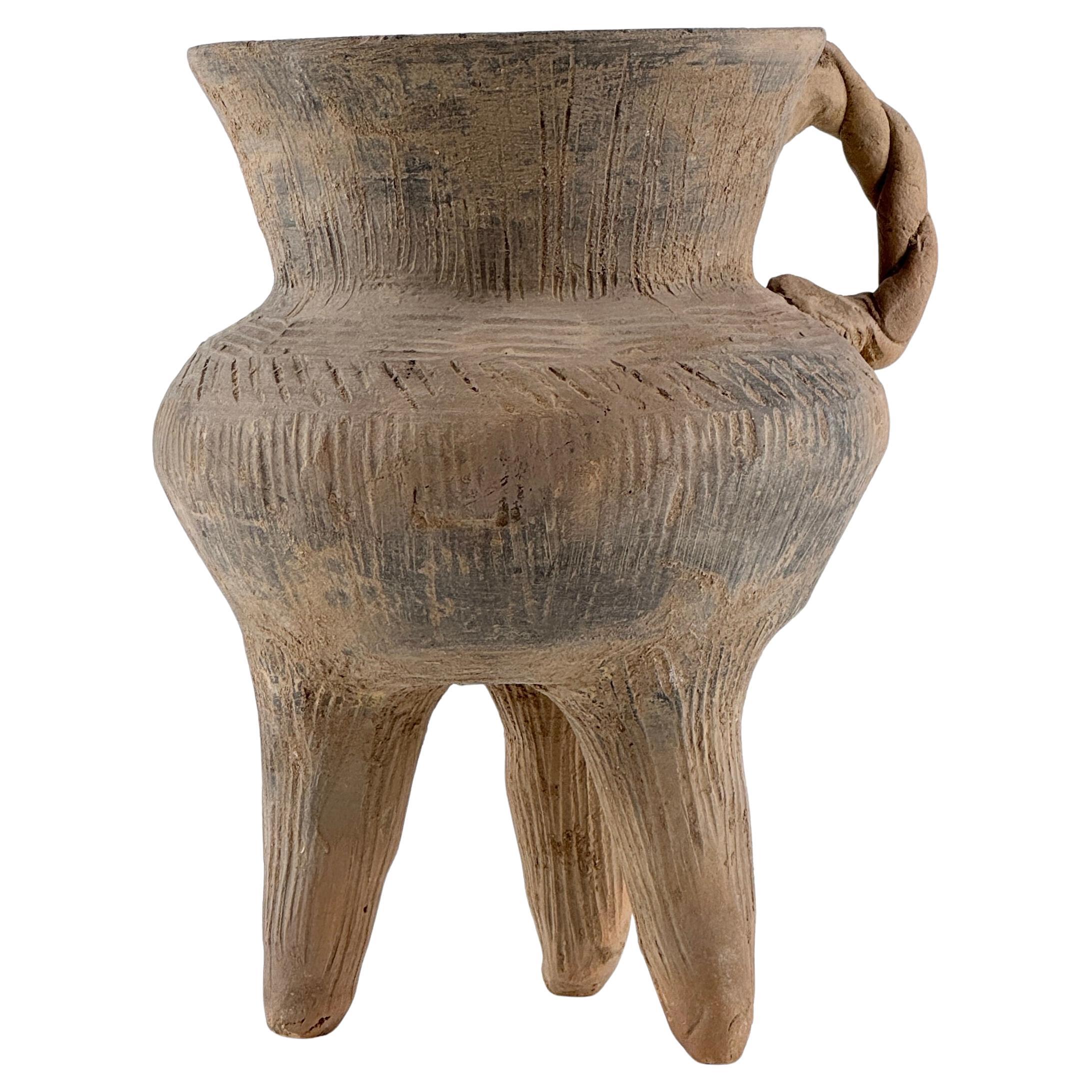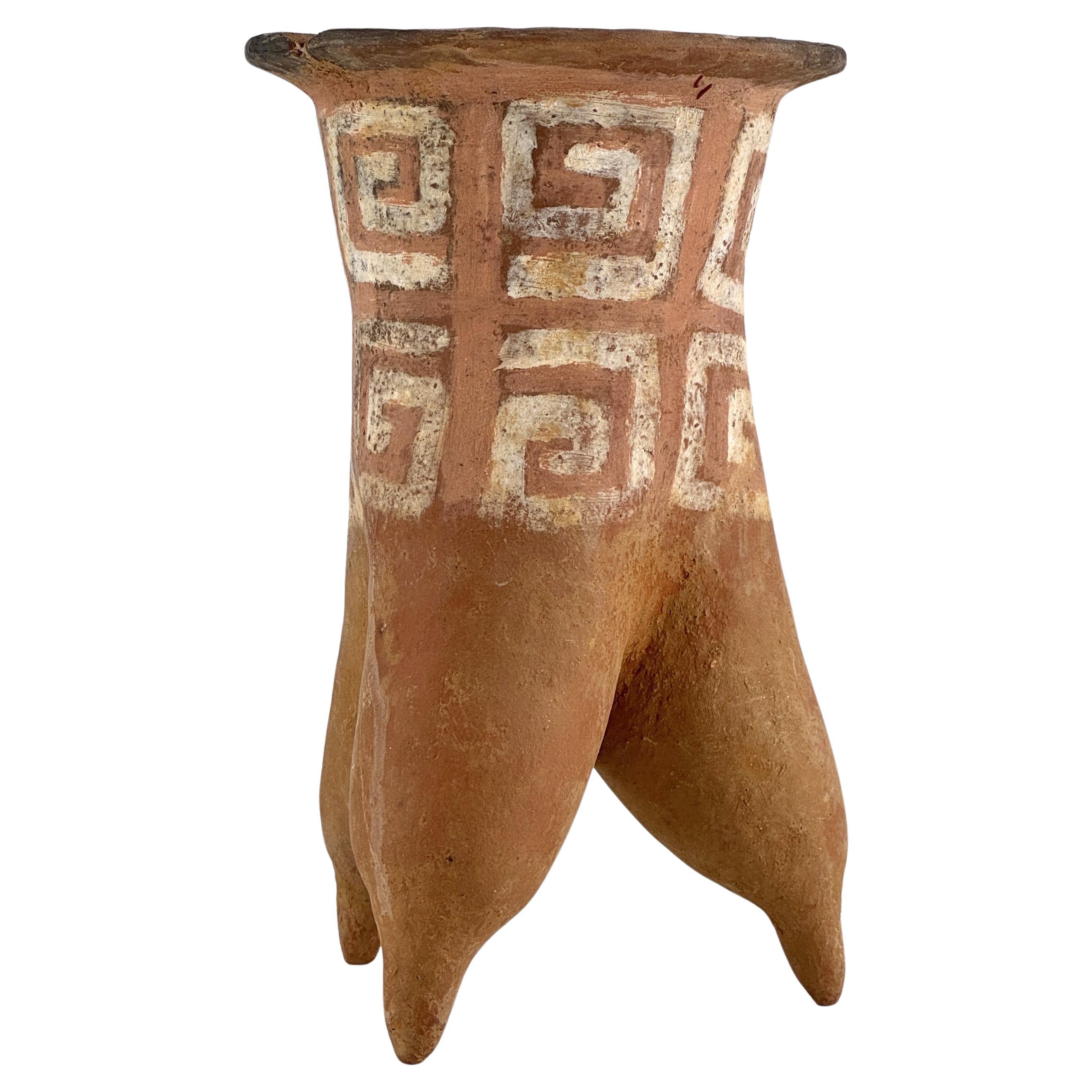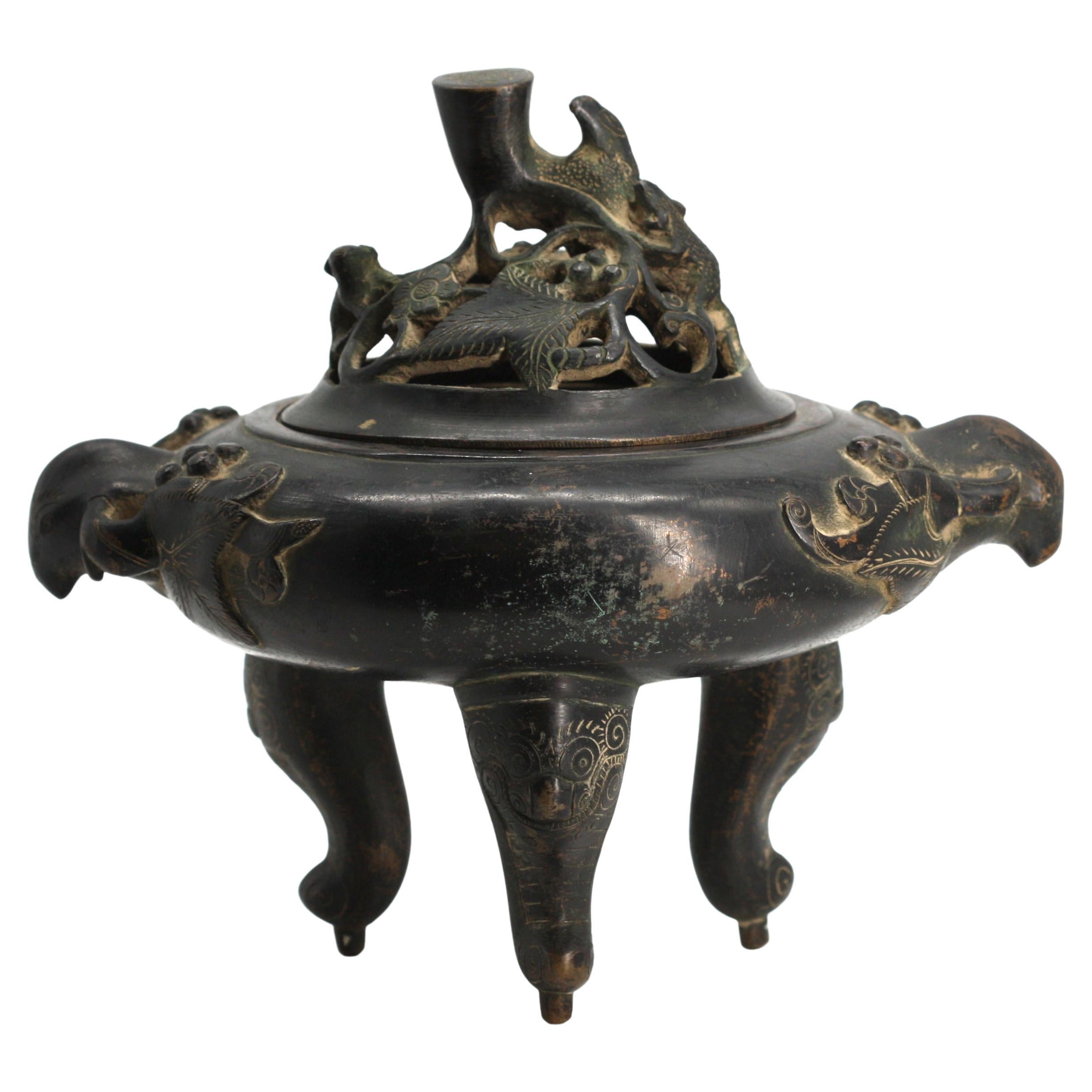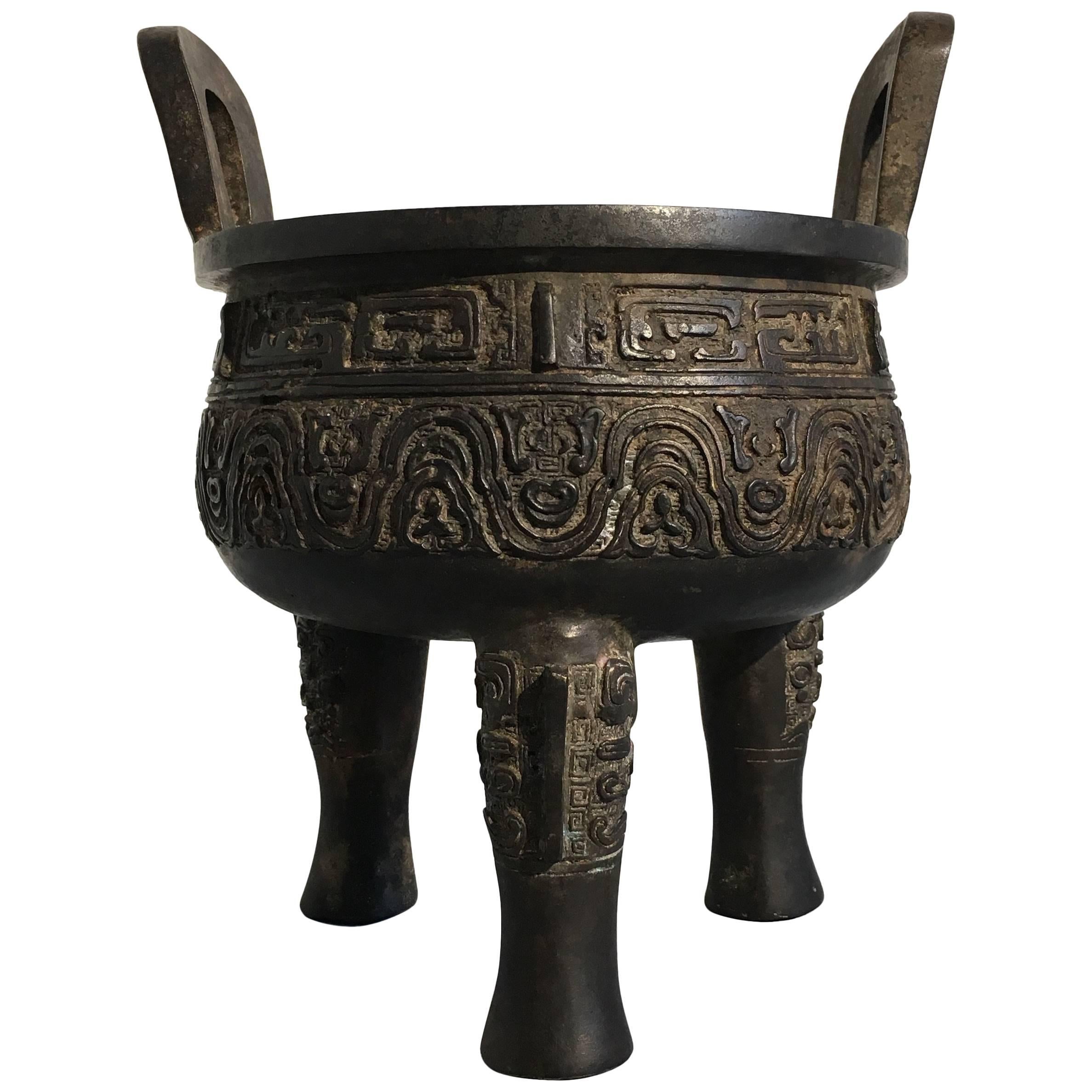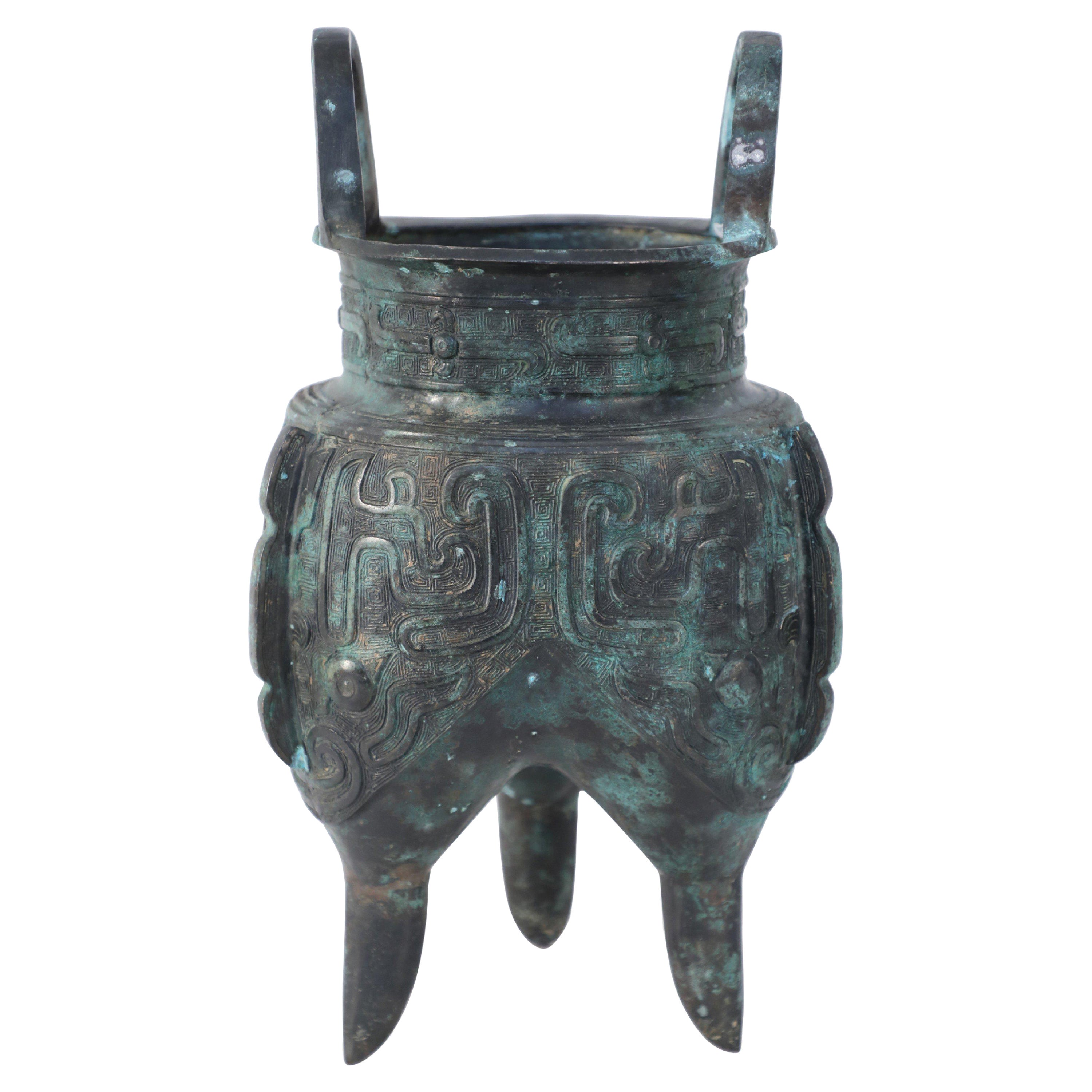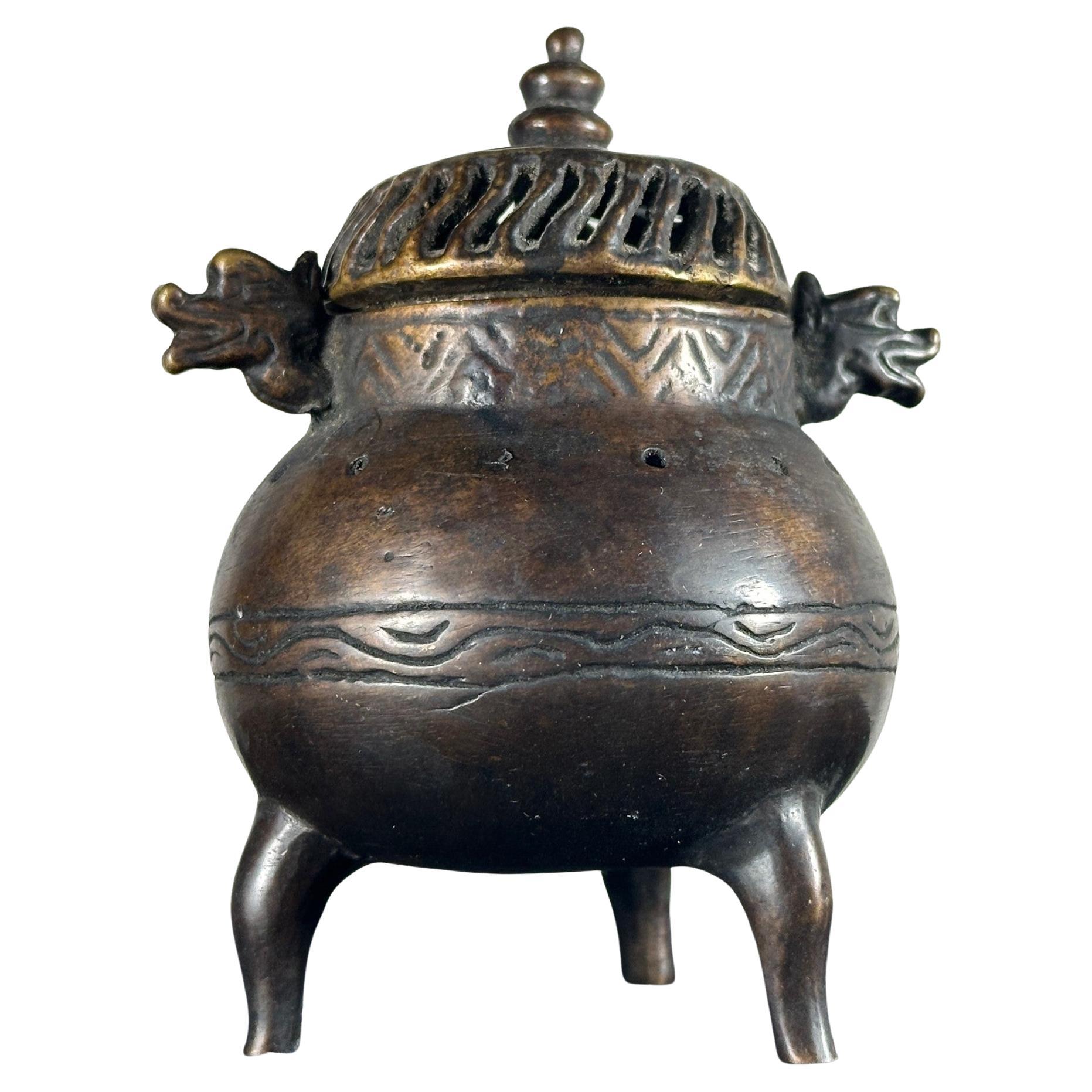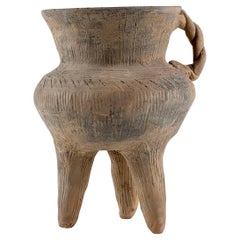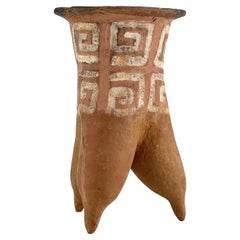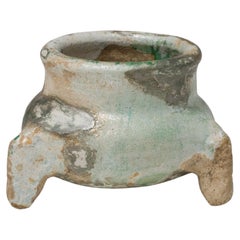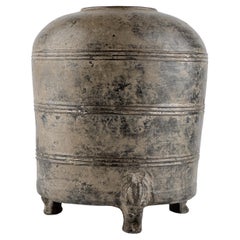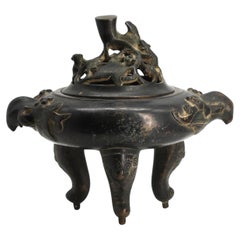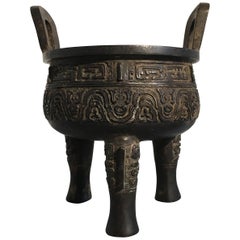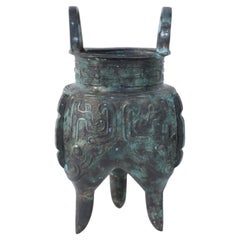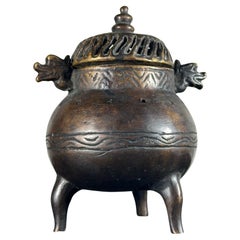Items Similar to Tripod in the shape of a bronze vessel li, Zhou or Shang dynasty
Want more images or videos?
Request additional images or videos from the seller
1 of 13
Tripod in the shape of a bronze vessel li, Zhou or Shang dynasty
$3,495
$6,99050% Off
£2,651.93
£5,303.8550% Off
€3,032.24
€6,064.4850% Off
CA$4,881.57
CA$9,763.1350% Off
A$5,427.64
A$10,855.2850% Off
CHF 2,834.01
CHF 5,668.0350% Off
MX$66,067.58
MX$132,135.1650% Off
NOK 36,160.78
NOK 72,321.5550% Off
SEK 33,880.92
SEK 67,761.8450% Off
DKK 22,630.16
DKK 45,260.3350% Off
Shipping
Retrieving quote...The 1stDibs Promise:
Authenticity Guarantee,
Money-Back Guarantee,
24-Hour Cancellation
About the Item
The tri-lobed shape and combed ridges of this cooking pot increased heating efficiency by maximizing the vessel’s surface area. The shape of a bronze vessel li, with the body rising out of three hollow pointed legs to a wide moiuth with splayed-out rim. The exterior is covered with cord impressed pattern. The surface shows signs of oxidation from being buried in the soil for a long time.
Period: Zhou or Shang dynasty circa 1000 B.C.E.
Medium : Grey earthenware with impressed decoration
Type : Tripod vessel
Size : 29cm (Height) x 35cm(Diameter)
Condition : Good
Provenance : Acquired in late 1990s from Hongkong
Reference :
1) V&A Museum - ACCESSION NUMBER C.87-1954
2) Smithsonian National Museum of Asian Art - ACCESSION NUMBER F1984.13
3) The University of Chicago - OBJECT NUMBER 1989.1
4) The MET - Accession Number: 1972.275.5
5) Kyoto National Museum - Three-footed Earthenware Vessel
* Shang Dynasty Pottery (1600-1046 BCE)
The Shang dynasty, known for its significant advancements in bronze casting, also produced notable pottery. Shang pottery is characterized by its practical use and simple designs, reflecting the utilitarian needs of the society. The pottery from this period includes both coarse wares used for everyday purposes and fine, high-quality ceramics used in ritualistic contexts. Common forms include jars, bowls, and cups, often with a dark, burnished surface. One distinctive feature of Shang pottery is the use of gray clay, and many pieces display clear signs of oxidation, giving them a unique, mottled appearance. The decorations were typically incised or stamped, featuring geometric patterns, zoomorphic designs, and motifs that are also seen in Shang bronze works.
* Zhou Dynasty Pottery (1046-256 BCE)
The Zhou dynasty saw the continuation and further development of pottery techniques. Zhou pottery is often more refined than its Shang predecessors, showing greater variety and complexity in forms and decorations. The use of the potter’s wheel became more widespread during this period, allowing for more uniform and intricate shapes. Common pottery items included storage jars, cooking vessels, and ritual wares, often adorned with more elaborate designs. The Zhou dynasty also introduced glazing techniques, resulting in a range of color finishes from green to brown. The pottery from this era often features incised decorations, with motifs that include dragons, mythical animals, and intricate geometric patterns, reflecting the sophisticated artistry of the time.
Both Shang and Zhou dynasty potteries are valuable for understanding the daily life, cultural practices, and technological advancements of ancient China. These artifacts, often unearthed with clear signs of oxidation, provide a tangible link to the past, revealing the evolving craftsmanship and aesthetic preferences of these early Chinese civilizations.
- Dimensions:Height: 11.42 in (29 cm)Diameter: 13.78 in (35 cm)
- Materials and Techniques:
- Place of Origin:
- Period:
- Date of Manufacture:BCE 1,000
- Condition:Minor fading.
- Seller Location:seoul, KR
- Reference Number:1stDibs: LU9577240297662
About the Seller
4.8
Gold Seller
Premium sellers maintaining a 4.3+ rating and 24-hour response times
Established in 1999
1stDibs seller since 2023
38 sales on 1stDibs
Typical response time: <1 hour
- ShippingRetrieving quote...Shipping from: seoul, Korea South
- Return Policy
Authenticity Guarantee
In the unlikely event there’s an issue with an item’s authenticity, contact us within 1 year for a full refund. DetailsMoney-Back Guarantee
If your item is not as described, is damaged in transit, or does not arrive, contact us within 7 days for a full refund. Details24-Hour Cancellation
You have a 24-hour grace period in which to reconsider your purchase, with no questions asked.Vetted Professional Sellers
Our world-class sellers must adhere to strict standards for service and quality, maintaining the integrity of our listings.Price-Match Guarantee
If you find that a seller listed the same item for a lower price elsewhere, we’ll match it.Trusted Global Delivery
Our best-in-class carrier network provides specialized shipping options worldwide, including custom delivery.More From This Seller
View AllPottery Tripod Vessel, Neolithic Period
Located in seoul, KR
The sturdy triangular legs, wide mouth, convex body, and diagonal incised patterns create a harmonious balance, showcasing a form that is both primitive and refined. Notably, the twi...
Category
Antique 15th Century and Earlier Hong Kong Antiquities
Materials
Earthenware, Pottery
$1,400 Sale Price
30% Off
Lower Xiajiadian Culture Tripod Li Jar, 2000–1500 BCE
Located in seoul, KR
This tripod jar, dating from 2000 to 1500 BCE, is attributed to the Lower Xiajiadian Culture, which flourished in Northeast China. It exemplifies the early ceramic craftsmanship of N...
Category
Antique 15th Century and Earlier Hong Kong Antiquities
Materials
Earthenware, Pottery
$4,875 Sale Price
35% Off
Green-Glazed Tripod Vessel, Han Dynasty
Located in seoul, KR
Han Dynasty green-glazed tripods are comparatively rare, especially ones that have retained their structural integrity and glaze over millennia. Pieces in good condition are scarce b...
Category
Antique 15th Century and Earlier Hong Kong Han Antiquities
Materials
Earthenware
$1,235 Sale Price
35% Off
Grey Tripod Granary Jar, Han dynasty
Located in seoul, KR
The vessel consists of a rounded cylindrical body, a gently curved upper section, and a small circular opening, suggesting that it was used for storing grain or valuable goods.
Thre...
Category
Antique 15th Century and Earlier Hong Kong Han Antiquities
Materials
Earthenware
$1,300 Sale Price
35% Off
Sancai-Glazed Pottery Tripod Jar, Tang Dynasty
Located in seoul, KR
The globular body is supported on three claw feet and is covered in a splashed-glaze of amber, green and cream color, which stops short of the unglazed base.
Date : Tang Dynasty(61...
Category
Antique 15th Century and Earlier Hong Kong Tang Antiquities
Materials
Earthenware
$3,185 Sale Price
35% Off
Rare Longquan Celadon Tripod Incense Burner, Song-Yuan Dynasty
Located in seoul, KR
The vessel features a compressed body supported by three tapered feet and a flat, outwardly flaring rim. Three slender flanges originate from a subtle ridge on the shoulder and exten...
Category
Antique 15th Century and Earlier Hong Kong Antiquities
Materials
Celadon
$17,500 Sale Price
50% Off
You May Also Like
Chinese Patinated Bronze Tripod Covered Censor
Located in West Palm Beach, FL
Chinese Patinated Bronze Tripod Covered Censor
Qing Dynasty, the underside with an imperial six-character mark.
The flattened spherical vessel with a pierced lid, on animal mask tri...
Category
20th Century Antiquities
Materials
Bronze
Chinese Archaisit Cast Bronze Ding Tripod Censer, Early 20th Century, China
Located in Austin, TX
A well cast Chinese archaistic bronze tripod censer, ding, in the Ming style, Republic Period, early 20th century, China.
Heavily cast in the arc...
Category
Early 20th Century Chinese Archaistic Metalwork
Materials
Bronze
Chinese Han Dynasty-Style Patinated Bronze Tapered Leg Vessel
Located in Queens, NY
Antique Chinese Han Dynasty-style copy of a patinated bronze vessel carved with raised geometric and serpentine patterns, sitting atop three tapered legs and finished with two c-shap...
Category
20th Century Chinese Chinese Export Antiquities
Materials
Bronze
Chinese Qing Dynasty Small Bronze Tripod Censer
Located in Vero Beach, FL
Chinese Qing Dynasty Small Bronze Tripod Censer
Small bronze censer from the Qing Dynasty 1644-1912, standing on three cabriole legs. Twin handles depict mythical creatures’ heads. ...
Category
Antique 19th Century Chinese Qing Metalwork
Materials
Bronze
Very Late 18th-Early 19th Century Cast Bronze Chinese Archaistic Vessel
Located in Hudson, NY
This Chinese cast bronze urn was made to pay honor to the fine vessels produced in the Shang, Zhou and Han periods. This work cast in the late 18th into the early 19th century (circa...
Category
Antique 1790s Chinese Archaistic Metalwork
Materials
Bronze
China Zhou Dynasty Bronze Perfume Burner
Located in Beuzevillette, FR
Bucket burns perfume in bronze resting on three feet. The body is sculpted with a band frieze with an archaic motif. Two inverted U-shaped handles punctuate the edge. This type of bronze bucket was cast with lost wax from molds in several parts and assembled when the piece was poured, these are the traces that can be seen on the back of the bucket. . The bronze has a beautiful green and dark gray excavation patina. This perfume burner was originally to have longer feet, no doubt arched, cut very long ago since the place of the cut has the same patina as the rest of the piece.
China Zhou Dynasty...
Category
Antique 15th Century and Earlier Chinese Archaistic Antiquities
Materials
Bronze
More Ways To Browse
Antique Bronze Vessels
Antique Furniture In Chicago
Tripod Bronze
Bronze Dynasty
Antique Pottery Stamps
Green Asian Vessels
Ancient Chinese Artifacts
Antique Cooking Pots
Dragon Pottery
Antique 3 Wheeler
Dragon Jar
Chinese Storage Jar
Shang Dynasty
Chinese Tripod
Dragon Cup
Chinese Ritual Vessels
Kyoto Pottery
Antique Dragon Jar
